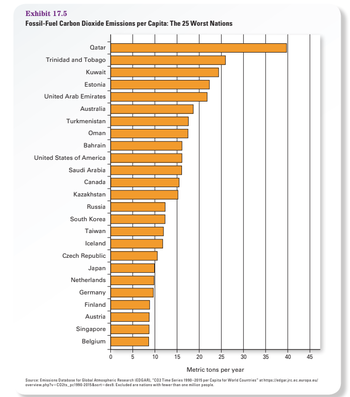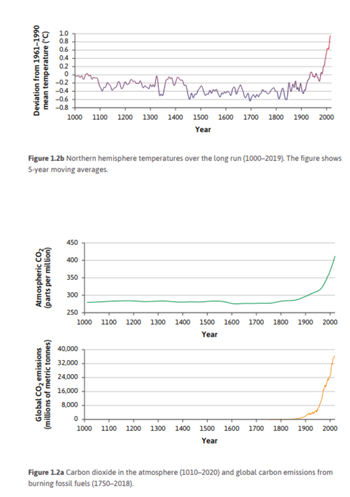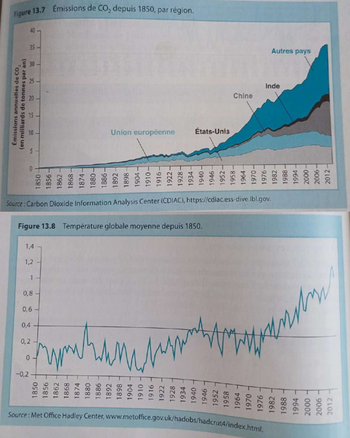- Home
- SUMMARY
- BY TEXTBOOK Apri sottomenù
-
BY TOPIC
Apri sottomenù
- S1 : Greenhouse effect
- S2 : Anthropogenic cause
- S3 : Future scenarios of temperature increases
- S4 : Impacts on Earth’s systems
- S5 : Impacts on economic and social systems
- E1 : Mitigation as a social dilemma
- E2 : Carbon pricing
- E3 : Discounting in reference to climate change
- E4 : Inequality in reference to climate change
- E5 : Social Cost of Carbon and IAMs
- E6 : Persistency & irreversibility in reference to climate change
- E7 : Climate decision-making under uncertainty
- E8 : Climate policies
- E9 : Behavioural issues in reference to climate change
- E10 : Adaptation and geoengineering
- SAMPLE LECTURE
- ABOUT US
S2 : Anthropogenic cause
Any statement on human activities as the primary cause of climate change will be recorded in this section. We will also take into account the mention of climate change denial.

US-1-m
287
Though the science is not yet fully resolved, fossil fuel used to power the likes of automobiles and electricity generators produces carbon dioxide, which mixes with other greenhouse gases that could contribute to climate change.
294
Overall, the United States is the second-largest emitter of carbon dioxide, accounting for 14 percent of the global total. China is the largest emitter and is responsible for 29 percent of global carbon dioxide emissions.
US-2-m
40
Global warming is largely caused by carbon emissions from coal, oil, and other fossil fuels.
235
Think about automobiles for a minute. They not only contribute to the global warming problem but also create traffic congestion.
US-3-m
624
According to the UN report, human activity—pollution—is causing temperatures to rise. At least 97% of actively publishing climate scientists agree that the climate-warming trends over the past century are likely due to human activities, as do the Academies of Science from 80 different countries.
697
Emissions of carbon dioxide and other greenhouse gases have increased dramatically over the past century as economic growth has been accompanied by the greater use of fossil fuels, which has in turn led to an increase in atmospheric concentrations of GhGs.
US-4-m
1043
The source of the vast majority of greenhouse gases is human activity—specifically, the burning of fossil fuels such as coal, oil, and natural gas which are derived from fossil sources and are used to generate electricity or power vehicles.
1064
A history of heavy reliance on fossil fuels which emit greenhouse gases has led to problems created by climate change.
US-5-m
697
Emissions of carbon dioxide and other greenhouse gases have increased dramatically over the past century as economic growth has been accompanied by the greater use of fossil fuels, which has in turn led to an increase in atmospheric concentrations of GhGs.
US-6-m
47
The vast majority of scientists believe that human activities are impacting the global climate.
65
The intensive use of fossil fuels depletes petroleum reserves, degrades air quality, and contributes to global climate change.
194
According to the OECD, the most significant environmental impact of expanded global trade is higher emissions of carbon dioxide (CO2), the main greenhouse gas. Consider that 2–4 percent of global fossil fuel use is for ocean shipping. Air shipping results in the highest CO2 emissions per ton of freight, and about 40 percent of world trade is now shipped by air. The OECD notes that a 1 percent increase in trade leads to a 0.6 percent increase in CO2 emissions for the average country.
255
About 10 times the polyester’s weight is released in carbon dioxide, contributing to global climate change.
[...]
Each transportation step involves the release of additional air pollution and carbon dioxide.
425
The scientific consensus on climate change is well-established—approximately 97 percent of scientists studying the issue conclude that human emissions of various greenhouse gases, primarily carbon dioxide (CO2), are significantly impacting the global climate system.
426
Humans can influence the global climate by the emissions of various greenhouse gases.
[...]
Although various greenhouse gases exist naturally in the earth’s atmosphere and make life possible on earth, human activities have increased the concentration of many of these gases and introduced greenhouse gases into the atmosphere that do not occur naturally. The most relevant greenhouse gas emitted by humans is carbon dioxide (CO2), which is formed when fossil fuels (coal, oil, and natural gas) are burned. Other important greenhouse gases include methane, nitrous oxide, and chlorofluorocarbons (CFCs).
427
A 2014 IPCC report concludes that human emissions of greenhouse gases “are extremely likely to have been the dominant cause of the observed warming since the mid-20th century” and that “continued emission of greenhouse gases will cause further warming and long-lasting changes in all components of the climate system.”
US-7-m
164
Nevertheless, most scientists are convinced that the recent warming trend is not part of the natural fluctuations in temperature but is primarily a result of the burning of fossil fuels, such as coal, natural gas, and petroleum.
US-8-m
761
Electricity generation and usage is a major source of climate change , which is considered one of the most consequential external costs of our lifetime.
799
Among the most significant economic issues facing the world today is the effect of human actions on the environment.
[...]
Climate change refers to the gradual change in the Earth's climate due to an increase in average temperatures resulting from both natural and human actions.
800
Greenhouse gases created largely by human activities include carbon dioxide (CO2) from fossil fuel and industrial processes, carbon dioxide (CO2) from forestry and other land use (FOLU), methane (CH4), nitrous oxide (N2O), and fluorinated gases (F).
801
The largest portion of greenhouse gases is carbon dioxide, which is created by fossil fuel usage, industrial production, and deforestation. Fossil fuel usage includes the use of automobiles and airplanes, electricity and home heating fuels, and the production of products such as plastics and tires and even everyday items such as ink pens, cosmetics, and toothpaste. Deforestation contributes to greenhouse gases because trees absorb carbon dioxide, and when they are cut down or burned, the stored carbon dioxide is released into the atmosphere.
[...]
Other forms of greenhouse gases include methane, nitrous oxide, and fluorinated gases. Methane is generated largely from livestock farming, landfills, and the production and use of fossil fuels. Nitrous oxide is produced on farms from the use of synthetic fertilizers along with fossil fuel usage.
802
Finally, fluorinated gases are created in products such as modern refrigerators, air conditioners, and aerosol cans. Because fluorinated gases do not harm the ozone layer and are energy efficient, products that emit these gases have grown in popularity over the past decade, though they still contribute significantly to global warming.
US-11-m
356
A steel firm may produce carbon emissions as well as steel, contributing both to air pollution and global warming.
359
Clearly, the most significant and hotly debated issue of externalities is global warming. The 2007 Nobel Peace Prize was awarded to former Vice President Al Gore and the Intergovernmental Panel on Climate Change, a group of 2,500 researchers from 130 nations that issued a number of reports linking human activity to the recent rise of the average temperature on Earth.
758
The impact of human actions that contribute to global climate change is one that economic policy tries to address, although not without significant challenges and obstacles.
US-12-m
29
More recently, climatologists have debated whether the earth is experiencing global warming and, if so, why.
120
But there are also studies claiming that humans have not contributed to climate change.
199
Some on the right dispute the wisdom of any government action to reduce carbon output, seeing global warming as wildly over-hyped if not entirely fictitious. Others simply think it would be dangerous to give the government the power to regulate so many economic activities. […].
US-15-m
626
Everyone agrees global warming is both real and caused by humans.

US-16-m
6
Evidence that our use of fossil fuels—coal, oil, and natural gas—has profoundly affected the natural environment of the planet is shown in Figures 1.2a and 1.2b. Each figure has the hockey stick shape.
[…]
The human causes and the reality of climate change are no longer widely disputed in the scientific community.
44
But many of the most important technological developments of the twentieth century from cars and aeroplanes to refrigeration and personal computers, have relied on carbon-based energy for their use as well as manufacture.
[…]
The evidence on biodiversity and climate change shows how dramatically the way we produce our livelihoods is now degrading the environment, and depleting the stock of natural resources—including clean air and a liveable climate.
47
The rising level of global output has contributed to climate change.
[…]
Contributing to both rising affluence and environmental threats was the introduction of new methods of production, increasing the amount a person can produce in an hour by harnessing energy based on burning carbon.
90
Capitalism + carbon = hockey stick growth + climate change
[…]
The Industrial Revolution marked the transition from an economy in which photosynthesis is the source of most energy, so that land is a constraint on growth, to an energy-rich economy based on fossil fuels. The switch to coal was a necessary condition for the Industrial Revolution.
91
Starting in the eighteenth century, humans learned how to use the energy available from nature (burning carbon) to transform the production of goods and services.
[…]
This threatening side-effect results from the particular combination of technologies and institutions that propelled the continuous technological revolution, which we summarize as ‘carbon plus capitalism’.
93
The production of energy is currently responsible for 87% of global greenhouse gas emissions.
100
Over the past two centuries, cheap coal, oil, and other carbon-based resources along with rising wages provided ongoing incentives to increase the use of energy and economize on labour. The resulting build-up of CO2 and other greenhouse gases caused dangerous increases in global temperatures.
US-1-M
30
More recently, climatologists have debated whether the earth is experiencing global warming and, if so, why.
306
But there are also studies claiming that humans have not contributed to climate change.
US-2-M
345
At present, world energy consumption is overwhelmingly dependent upon fossil fuels, which account for 81.4% of total consumption, while clean, renewable sources account for only 2.6%. Why? Because historically, fossil fuels have been cheaper to use. Most of today’s wealthy countries grew their economies through industrialization and the burning of fossil fuels over the last century.
FR-3-m
321
Concernant les externalités négatives, l’utilisation d’une centrale au charbon dans la production électrique produit une pollution de l’air affectant les riverains et contribue au changement climatique.
FR-1-M
296
Selon le géochimiste Paul Crutzen [2002], nous sommes entrés dans l'ère de l'anthropocène, c'est-à-dire une ère dans laquelle l'évolution de la Terre serait principalement déterminée par les activités humaines. En tant qu'actrice principale, l'espèce humaine serait à la fois coupable et victime de cette nouvelle ère.

FR-4-M
309
Depuis la Révolution industrielle, l'utilisation d'énergies fossiles (principalement le charbon) a fortement augmenté les émissions de CO2. Dans le même temps, on a constaté une hausse importante de la température globale moyenne. Les figures 13.7 et 13.8 montrent ces deux évolutions.
FR-7-M
53
L'activité humaine génère des émissions conséquentes de gaz à effet de serre, notamment de dioxyde de carbone, qui contribuent de manière significative à la hausse de la température à la surface du globe, c'est-à-dire au réchauffement climatique.
FR-2-B
146
Le changement climatique : On est sûr aujourd'hui de son origine anthropique, c'est-à-dire de la responsabilité première des hommes dans le phénomène, avec comme principale cause l'utilisation des énergies fossiles et, plus accessoirement, l'élevage et la déforestation. La courbe des températures, superposée à celle de la concentration en CO2 montre une nette rupture à partir de la révolution industrielle.
FR-4-B
481
Pour P. Crutzen et E. Stoermer, nous sommes entrés dans l'anthropocène : l'homme est la force géologique dominante sur la planète. Cette nouvelle ère géologique débute symboliquement en 1784, date du dépôt du brevet de perfectionnement de la machine à vapeur par J. Watt.